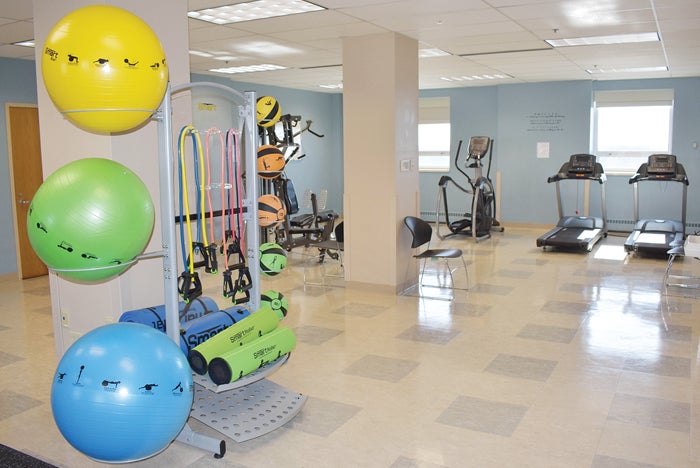Health systems invest in new addiction treatment facilities

The SSM Health Treatment & Recovery Program at St. Joseph Hospital–St. Charles for inpatient and outpatient care includes a gym, meditation and relaxation rooms and common spaces.
Photo courtesy of SSM Health St. Joseph Hospital
The opioid epidemic has been indiscriminate in its reach. More than 2 million Americans had an addiction to prescription or illegal opioids in 2016, according to the Substance Abuse and Mental Health Services Administration (SAMHSA). The previous year, 52,404 people lost their lives as a result of drug overdose (nearly two-thirds are attributed to opioids), causing drug overdose to surpass traffic crashes and gun violence as the leading cause of death by injury in the U.S. The growing crisis has prompted greater action by the federal and local governments and public health departments to battle the issue.
Health systems, too, have stepped up their efforts to address the concern by specially designing facilities that meet the needs of this patient group. The Centers for Disease Control and Prevention states that emergency department (ED) visits for opioid overdoses increased 30 percent from July 2016 to September 2017 in 52 areas across 45 states. The move to redirect care away from the ED and into the most appropriate care setting is growing. From 2003 to 2016, opioid treatment programs increased 39 percent, according to the latest numbers from SAMHSA.
SSM Health St. Joseph Hospital in St. Charles, Mo., opened a hospital-based treatment and recovery program in December in response to the opioid epidemic within its community. The hospital invested $100,000 to renovate space on its fourth floor to create the program, which is geared toward working professionals looking to reclaim their sobriety.
The clinic provides both inpatient and outpatient services for adults 18 and older who deal with mental health issues and substance misuse. It includes 10 double-bed patient rooms for inpatient care, a gym, meditation and reflection rooms, and common living spaces. One of the more striking features of the clinic is its mock living spaces in which therapists design simulations that place patients in situations that may cause them anxiety. The therapeutic simulations help to uncover underlying triggers so that patients can develop strategies to handle trials they may face in the real world.
In addition to hospital-based programs, health systems also are opting to build stand-alone facilities for addiction and recovery treatment. Avera Health recently announced plans to build an $8 million Avera Addiction Care Center in Sioux Falls, S.D. The project consists of two one-story buildings comprising 20,000 square feet. Plans include a main building with space for day treatment, group dining area and a meditation room appropriate for all faiths. The second building will be its residential facility featuring 32 private rooms and separate areas for men and women.
Leaders at Avera Health say the center is being designed with input from an advisory committee built of experts in addiction, community members and neighbors. Interior design plans call for a comfortable homelike environment to nurture a sense of peace and privacy. It also cultivates a connection to nature with an outdoor courtyard and walking trails on the property.
The Avera McKennan Foundation has raised approximately $1 million to help fund the project. David Flicek, president and CEO of Avera McKennan Hospital & University Health Center, says the donations signal that its supporters “see this as a community need, and want to help individuals and families return to health.”
Construction on the project is set to begin this summer, with the center opening in 2019.
Matt Stanley, D.O., vice president of the Avera Behavioral Health Service Line and Avera Medical Group psychiatrist, says the center and the care that will be offered there are being designed in a way to maintain the dignity of its patients.
“We are proud to be able to offer access to high-quality addiction care in a beautiful, respectful and hopeful environment,” Stanley says. “Families and individuals in our area whose lives are torn by addiction deserve no less.”—




